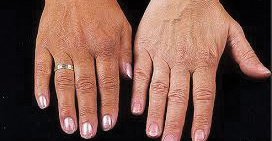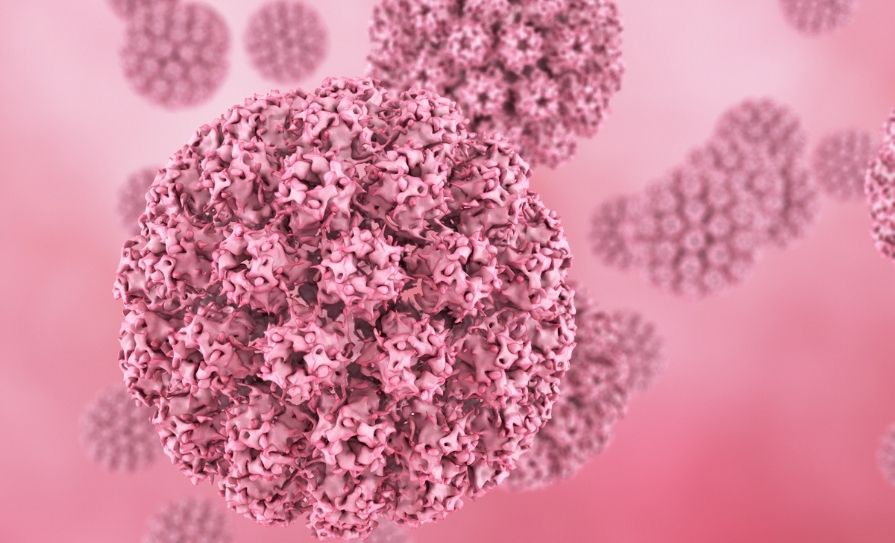An overview of the clinical manifestations of Addison’s disease, with diagnosis and treatment guidance
Addison’s disease (AD), often referred to as primary adrenal insufficiency or hypoadrenalism, is a rare endocrine disorder which occurs when the adrenal glands do not produce enough of the hormone cortisol and in some cases, aldosterone. The disease is characterised by weight loss, muscle weakness, fatigue, hypotension, and sometimes darkening of the skin in both exposed and non-exposed areas of the body. It affects approximately in 100,000 people, occurs in all age groups, but usually individuals aged 30-to-50 years and affects men and women equally. In rare cases, Addison’s disease has been noted to occur in families, suggesting a genetic predisposition to developing the disorder.
Addison’s disease occurs when the adrenal glands become damaged and do not produce enough of the steroid hormones glucocorticoids (especially cortisol) and mineralocorticoids (especially aldosterone).
Primary adrenal insufficiency
The commonest causes of Addison’s disease are autoimmune disorders and tuberculosis (TB). While TB is the most common cause of Addison’s disease in developing countries, most cases of Addison’s disease are caused by the gradual destruction of the adrenal cortex, the outer layer of the adrenal glands, by the body’s own immune system. About 70 per cent of reported cases of Addison’s disease are due to autoimmune disorders. Several autoimmune processes can lead to adrenal insufficiency either affecting the adrenal glands exclusively, or as part of a more complex inherited autoimmune polyglandular syndrome. Other causes include certain medications, sepsis, and bleeding into both adrenal glands. Less common causes of primary adrenal insufficiency are chronic infections, mainly fungal infections; cancer cells spreading to the adrenal glands; amyloidosis; and surgical removal of the adrenal glands.
Secondary adrenal insufficiency
Secondary adrenal insufficiency is caused by insufficient ACTH produced by the pituitary gland or CRH produced by the hypothalamus. It causes a drop in the production of cortisol, but not aldosterone. A temporary form of secondary adrenal insufficiency can occur when a person receiving glucocorticoid hormones such as prednisone for a long time abruptly stops taking the medication. Another cause of secondary adrenal insufficiency is the surgical removal of benign ACTH-producing tumours of the pituitary gland. Although less common, adrenal insufficiency can occur when the pituitary gland decreases in size or stops producing ACTH. This can result from tumours or infections of the area, loss of blood flow to the pituitary, radiation for treatment of pituitary tumours, or surgical removal of parts of the hypothalamus or the pituitary gland during neurosurgery.
Addison’s disease is associated with the development of other autoimmune diseases such as type 1 diabetes, Hashimoto’s thyroiditis, coeliac disease, and vitiligo. Psychiatric symptoms such as mood disturbances, decreased motivation and behavioural changes are also frequently associated with the condition.
Hyponatraemia and hyperkalaemia are commonly associated with Addison’s disease, while hypoglycaemia is uncommon. The patient usually complains of gastrointestinal upset with anorexia, nausea, vomiting and diarrhoea, and a craving for salty foods can occur due to salt loss. In women, menstrual periods may become irregular or stop. Adrenal calcification and enlargement are commonly seen in Addison’s disease associated with TB.
The symptoms of Addison disease increase in intensity over time and eventually lead to acute adrenal insufficiency, known as adrenal crisis. Symptoms of Addisonian crisis include sudden penetrating pain in the lower back, abdomen, or legs, severe vomiting and diarrhoea, followed by dehydration, low blood pressure and loss of consciousness. Adrenal crisis is a medical emergency and must be treated immediately. It can cause cardiac arrest, CVA, hypovolaemic shock and hypoxia. If left untreated, adrenal crisis can be fatal, leading to coma and death.
Diagnosis
A suspected diagnosis of Addison’s disease is often based upon a detailed patient history, thorough clinical examination and identification of characteristic findings. A confirmed diagnosis is made through a series of specialised biochemical tests, including the adrenocorticotropic hormone (ACTH) stimulation test and insulin-induced hypoglycaemia test. X-ray examination of the adrenal and pituitary glands is also useful in helping to establish the diagnosis. Adrenal insufficiency can be difficult to diagnose in the early stages. Because symptoms progress slowly, the condition is often not detected until a stressful event or illness occurs. In about 25 per cent of patients, symptoms first appear during an Addisonian crisis.
ACTH stimulation test/synacthen stimulation test
The ACTH stimulation test measures the ability of the adrenal cortex to respond to ACTH. Blood and/or urine cortisol levels (short/rapid ACTH test) are measured before and 30-to-60 minutes after a synthetic form of ACTH (Synacthen) is given by injection. The normal response after an injection of ACTH is a rise in blood and urine cortisol levels. Patients with either form of adrenal insufficiency respond poorly or do not respond at all. If the response to the short ACTH test is abnormal, a ‘long’ ACTH stimulation test is carried out to determine the cause of adrenal insufficiency. ACTH is injected intravenously or intramuscularly over a 48-to-72-hour period, and blood and/or urine cortisol are measured the day before and during the two to-three days of the injection. Individuals with primary adrenal insufficiency do not produce cortisol during the 48-to-72-hour period; however, those with secondary adrenal insufficiency have adequate responses to the test on the second or third day.
Insulin-induced hypoglycaemia test
Insulin-induced hypoglycaemia is a reliable test to determine how the hypothalamus, pituitary and adrenal glands respond to stress. Blood glucose and cortisol levels are measured, followed by an injection of fast-acting insulin and levels are measured again at 30, 45, and 90 minutes after the insulin injection. The normal response is for blood glucose levels to fall and cortisol levels to rise.
Thyroid function tests may also be carried out, as many people with Addison’s disease have hypothyroidism.
Other diagnostic tests
Once a diagnosis of primary adrenal insufficiency has been made, x-ray of the abdomen may be taken to detect if the adrenals have any signs of calcium deposits, which could indicate TB. If secondary adrenal insufficiency is determined to be the cause, a CT scan may be used to check the size and shape of the pituitary gland. The function of the pituitary gland and its ability to produce other hormones are also tested.
Treatment
In the majority of cases of Addison’s disease, treatment will involve corticosteroid replacement therapy, which is ongoing for life. Cortisol is replaced orally with hydrocortisone tablets, a synthetic glucocorticoid, taken once or twice a day. Other medicines used are prednisolone or dexamethasone, although these are less-commonly prescribed. If aldosterone is also deficient, it is replaced with oral doses of a mineralocorticoid, fludrocortisone acetate (Florinef), taken once a day and patients are usually advised to increase their salt intake. Patients with secondary adrenal insufficiency normally maintain aldosterone production, so do not require aldosterone replacement therapy. The doses of these medications are adjusted to meet the needs of individual patients.
During Addisonian crisis, hypotension, hypoglycaemia and hyperkalaemia can be life-threatening, however, therapy with intravenous hydrocortisone, saline, and dextrose usually provide a rapid improvement. When the patient can take fluids and medications by mouth, the amount of hydrocortisone is decreased until a maintenance dose is achieved. If aldosterone is deficient, maintenance therapy also includes oral doses of fludrocortisone acetate.
In most cases, underlying causes of Addison’s disease can be treated. TB is treated with a course of antituberculosis medication taken over a period of at least six months. Other infections may be treated with antibiotics or antifungal medication accordingly. While autoimmune conditions can be treated, they cannot usually be cured.
Patients with chronic adrenal insufficiency who require surgery under general anaesthesia are treated with hydrocortisone injections and saline. Injections commence the evening before surgery and continue until the patient is fully awake and able to take medication orally.
The dosage is adjusted until the maintenance dosage given before surgery is reached.
Women with Addison’s disease who are pregnant must be thoroughly monitored throughout their pregnancy to ensure the absence of complications. Pregnant women with primary adrenal insufficiency are treated with standard replacement therapy. If nausea and vomiting in early pregnancy interfere with oral medication, injections of the hormone may be necessary. During delivery, treatment is similar to that of patients requiring surgery. Following delivery, the dose is gradually tapered and the usual maintenance doses of hydrocortisone and fludrocortisone acetate by mouth are not reached until about 10 days after childbirth.
Patients with Addison’s disease should wear or carry a medical alert such as an ID card, bracelet or necklace and be prescribed and carry an emergency injection kit at all times in case of adrenal crises. Each year, approximately 8 per cent of people with Addison’s disease experience adrenal crisis requiring extra steroid medication immediately, in the form of an emergency injection of intra-muscular hydrocortisone (100mgs). A person with Addison’s disease should also know how to increase medication during periods of stress or upper respiratory infections.
While Addison’s disease is a serious illness, the prognosis for many people living with the condition is good. Most people can expect to live relatively normal lives, with a good life expectancy, if they receive ongoing good care and treatment.
Assessment, monitoring, audit and evaluation for disease activity, progression, and effects of the therapeutic regimen on a patient with Addison’s disease is a continuous process. By implementing person-centred care, monitoring and evaluating symptoms, outcomes and responses to therapy, clinicians play a pivotal role in managing the illness and improving the patient’s quality of life.
Support
Addison’s Ireland is the Irish branch of the Addison’s Disease Self-Help Group (ADSHG) with over 100 members from around the country, both north and south. It works to raise awareness of Addison’s in Ireland, support people and families affected by the condition and organises regular meetings in Dublin and around the country. The ADSHG Dublin Conference 2019 will take place in Dublin on Saturday, 5 October.
The ADSHG has also produced a range of clinical guidance
publications in collaboration with its Clinical Advisory Panel (CAP) to inform
and advise healthcare professionals, as well as useful patient information and
support documents, which can be downloaded from www.addisonsdisease.org.uk/caring-for-the-addisons-patient.
These resources include:
Emergency wallet card
The emergency wallet card is credit card-sized and contains advice, authored by the ADSHG CAP, on the treatment required to prevent an adrenal crisis in the event of serious injury or illness. It is available in printed form and is sent free to every member when they become a member.
Adrenal crisis care letter
This simple adrenal crisis protocol gives emergency medical treatment guidance for paramedics or hospital staff in the event of a person with Addison’s suffering an adrenal crisis. This letter should be signed by the patient’s doctor. This document is also available in eight foreign languages for those who live or travel abroad.
For those working in primary care:
Reducing risk of acute adrenal crisis: How to avoid precipitating an acute adrenal crisis (article by Prof John Wass).
Diagnosing Addison’s — a guide for GPs: The leaflets, ‘Diagnosing Addison’s — a guide for GPs’ and ‘Caring for the patient with Addison’s: Information for GPs’ have been developed for the ADSHG by its CAP, led by Prof Wass.
The first leaflet outlines the role of the GP in the early detection of Addison’s disease and covers information on symptoms and clinical signs, primary care investigations and referral, while the second leaflet outlines the role of the GP in managing Addison’s disease at each stage in the patient life-cycle, from diagnosis to old age.
Paramedic training pack: Published in 2019, with contributions from the Addison’s CAP and South East Coast Ambulance Trust, this presentation summarises the latest paramedic best practices and the JRCalc (2017) guidelines. It includes patient testimony and case studies and is suitable for use in a teaching setting. It was produced for paramedics and first responders who want to gain a better understanding of Addison’s disease and emergency management protocols.
Tertiary care
Surgical guidelines: The ADSHG surgical guidelines are intended for the information of medics and healthcare professionals (including dentists) and have been developed for the ADSHG by its CAP. They explain what level of extra medication and monitoring patients with Addison’s disease will need in the event of most types of minor or major surgery or dental work.
Nursing the Addison’s patient: Notes for nurses was written with hospital ward nursing staff in mind, for those times when anyone with Addison’s becomes an inpatient. This might be for elective surgery or during the recovery from an adrenal crisis.
References available on request













Leave a Reply
You must be logged in to post a comment.